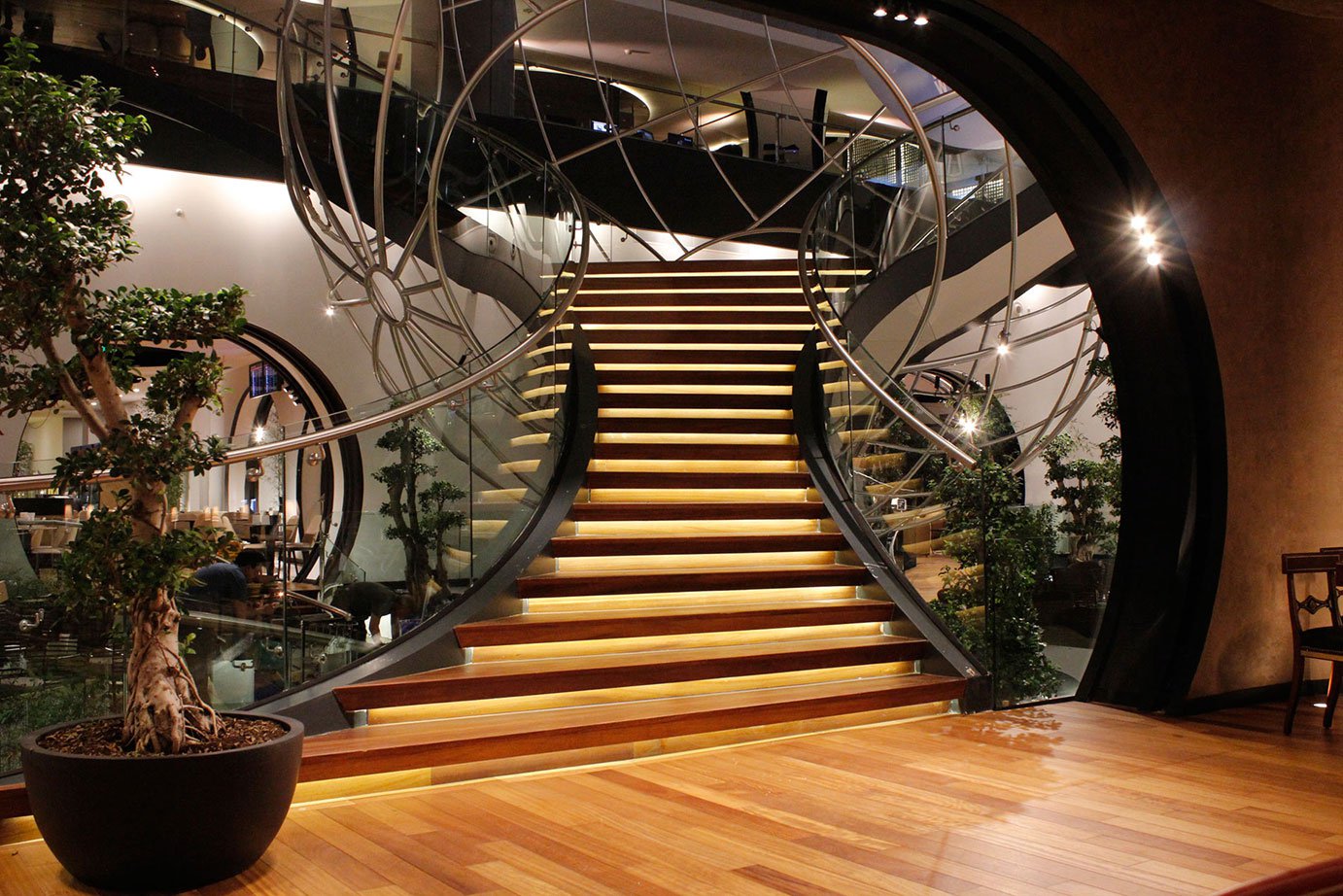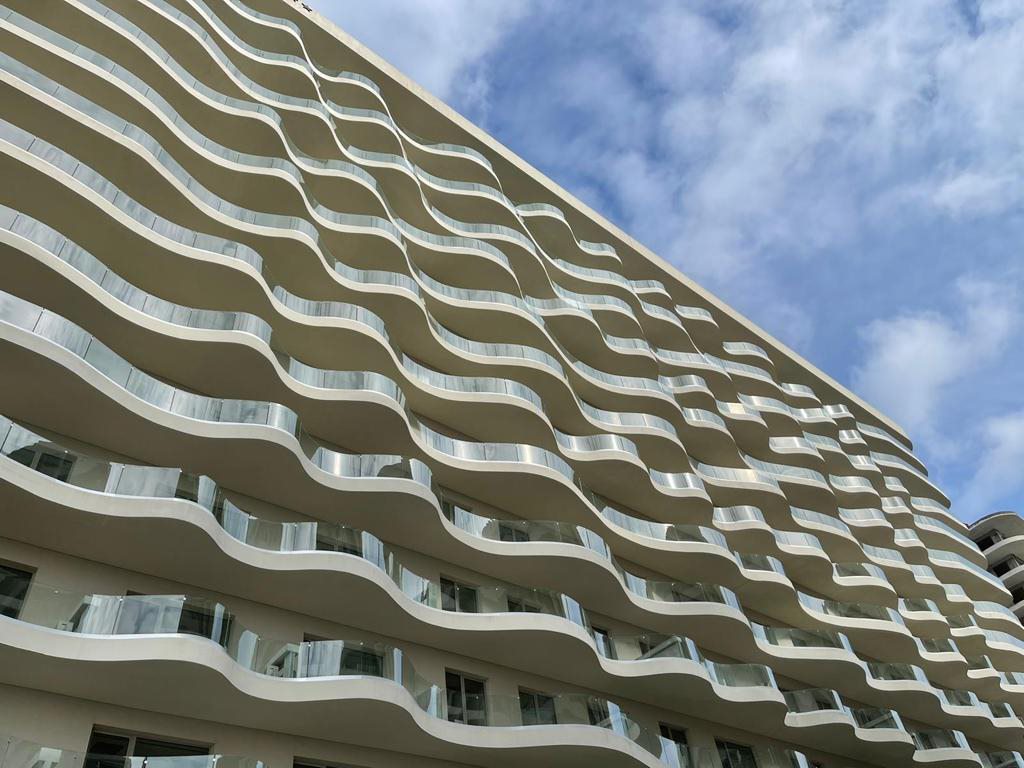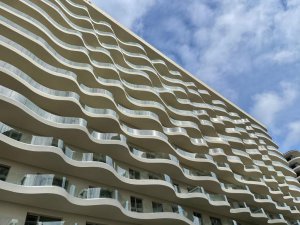Bent&tempered glass has the same physical and mechanical characteristics of horizontal tempered glass. After heating, the softened glass pane is bent between computer controlled bending jaws in order to form the desired radius followed by sudden cooling by compressed air.
Processes such as cutting, edge processing and drilling cannot be performed on bent&tempered glasses. Only sand blasting for decorative purposses is allowed. Bent glass is used on facades, balustrades, glass doors, furtniture glass, automative glass, etc.
| Dimenions | Max.: 2850 x 2200 / Min.: 200 x 350 (H x Yay boyu) |
| Radius | 6mm: R900 / 8mm - 10mm R1200 / 12mm - 15mm : R1500 |
Camglass Turkish Curved Bent Glass Manufacturer in Turkey
Curved glass, also called bent glass, is produced as tempered and non-tempered (mold camber) camber.

The tempered curved glass bending process is heated heavily until it reaches the melting point of flat glass, the glass starts to melt into a concave or convex mold with gravity, and after it melts the shape of the mold, it is slowly cooled and the bending process is completed.
The cooling process takes a long time, such as four to five hours. The reason for this is to reduce the internal stresses that will occur inside the glass and to prevent cracking and breakage. Considering the technical features of the glass, many designs are made with the bending process, it is possible to produce forms that may seem impossible.
There is an external intervention in the processes deemed necessary in the production of tempered curved glass.
The tempered dome glass bending process involves heating it to 600 degrees Celsius. The high temperature is enough to bring the glass to a state where you can bend it. By using mechanical pressure, we can shape the glass into the desired shape.
In tempered dished glass production, it is produced by adjusting the temperature, duration, and convection settings of the furnace, and the necessary settings for the dish (radius, pressure, blowing delay, blowing time, nozzle settings) according to the glass type and thickness.
Curved (bent) glass can be converted into safety glass. This can be achieved by laminating two curved glasses together.
When a dished tempered glass breaks, it is almost harmless to humans. This is because the glass pieces obtained from curved tempered glass are not sharper than other types of glass.
Curved tempered glass is often used in applications where people are nearby and safety is a high priority.
It is a preferred product for all architectural applications such as curved glazing, exterior viewing, and angle areas, skylights, solariums, covered walkways, interior walls, and balustrades.
Although it allows for many shapes, the non-tempered bombe is time-consuming.
With the heat treatment bending process, the glass is cooled very quickly after it reaches the desired curvature to increase its strength. The main challenges here are how to avoid optical distortions caused by the manufacturing process, and limitations with cylindrical shapes and concave shapes when it comes to coatings.
Curved glass gives architects and designers the freedom to create aesthetically pleasing curved glazed facades where straightness, corners, and edges can be enhanced by soft curves.
Various types of steel molds are used to stack flat glass into desired shapes.
In some cases, two or more pieces of glass are bent simultaneously to provide high-quality lamination and insulation following the bending process.
If the camber form is to be given to the flat glass in the quench, it should be paid attention that the Kevlar contacting the glass surface is clean and the level is the same. Otherwise, a dirty and uneven Kevlar may scratch the glass.
If the curved glass will be quenched, it should be ensured that the Kevlar contacting the paint surface is clean and the level is the same. Otherwise, a dirty and uneven Kevlar may scratch the paint.
For the control of curved tempered glasses, clearance or control templates should be available and control tolerances should be determined.
Since there is no TS and EN standard for curved tempered glasses yet, ISO 11485-1 and 2 standards should be provided and production should be made according to these standards.
Curved Glass Control Principles
The appearance quality of curved tempered glasses is made in a 2 m vertical position in normal daylight.
Size controls are made with a ruler with 0.5 mm precision.
Glasses that are out of this tolerance are separated incorrectly.
The linear error should not be seen when viewed from 2 m.
The bending process of the glass is the shaping of the mold according to the glass type, size, bending angle, thickness, and quality, provided that a certain heat is applied.
In exterior coatings; Tempered glasses are shaped by bending at certain angles.
In smaller furnaces, the decorative elements and furniture used in the interior are shaped by bending the float glass.
The twisting process in exterior cladding; can be classified as banana camber, conical camber, spherical camber, and cylindrical camber.
Bent glass is used in windows of cars, buses, yachts, and boats, in panoramic elevators, and various areas such as stair railings.
Thanks to the curved (twisted) glasses obtained by shaping the glass, the continuity of the light and the image can be ensured.
Bent (convex) tempered glass offers excellent mechanical strength and resistance to temperature changes.
Annealed bent glass is most common in windows and display cases where the need for safety glass is minimal.
When tempered dome glass is broken, it breaks into small pieces like membranes that have no cutting feature.
Bent (curved) tempered glass is 4-5 times stronger than annealed glass, thanks to a manufacturing process that consists of heating, bending, and rapidly cooling the glass.
The bending process provides a new functional and aesthetic quality to the glass.
Bent (Cranked) tempered glass gains all the advantages of tempered flat glass.
Bent (Cranked) tempered glass offers greater resistance to mechanical and thermal loads as well as resistance to temperature changes.
Curved glass models are special glass products that can be produced in sizes from 4 mm to 10 mm.
Curved glasses have high optical quality due to precise and slow collapse.
Curved glasses can be produced by laminating with transparent, colored, and printed PVB.
Annealing and slow cooling of the glass increases the surface tension in the glass, making it tougher.
In non-tempered curved glasses, large fractures occur as a structural behavior after breaking.
Curved glasses can be produced in many sizes, dimensions, curved and curved glasses.
There is no model of curved glasses.
The desired prototype is produced.
Edge processing must be applied to the glass before it becomes dished.
Glass dished cannot be made without edge processing.
Cutting, drilling, edge and surface treatments cannot be performed on the glass after tempering.
Tempered curved glass has high resistance to thermal stresses.
There will be cracks, flake waste, etc. on the edge of the glass that will be cambered. there should be no errors, such errors should be corrected.
Camber applied glass; fillet template etc. molds and camber conformity to standards
(BS ISO 11485-Curved Glass Standard for Buildings can be taken as a basis.) or factory
controlled by standards. When it identifies non-conformity with required standards
in parameters such as the residence time of the glass in the oven, temperature, air pressure, and glass-nozzle distance.
The nonconformity is corrected by making changes.
Flat glass, low iron glass, reflective glass, satin glass, colored glass, frosted glass, painted glass, sandblasted glass, and dark curved glass are produced.
In the painted glass, the painted surface must be processed in a way that faces upwards.
Before mass production, since there is a great variety of radius and size in curved glasses,
witness sample should be produced by making a trial on a project basis.
When tempered curved glass is produced, compression stress occurs on its surfaces and edges. Tensile stress occurs in the inner parts of the glass. Since these forces are in balance, the glass
unbreakable. This voltage difference makes tempered curved glass difficult to break.
Curved glasses can be produced with a logo.
If there is a hole in the glass to be curved, the hole diameter should not be smaller than the glass thickness.
In dished glass production, the burrs on the edge of the hole should be cleaned by countersinking. If the countersink is not performed, the glass from the edges of the hole during bending.
cause cracking or breakage.
Countless types of curved glass can be produced.
The classification system in ISO 11485-3:2014 is concerned with increasing personal safety by reducing cut and puncture injuries to persons and the containment properties of the material.
ISO 11485-3:2014 covers the fracture properties of tempered dome safety glass for use in buildings, including the shatter test and physical and mechanical properties.

 EN
EN 

